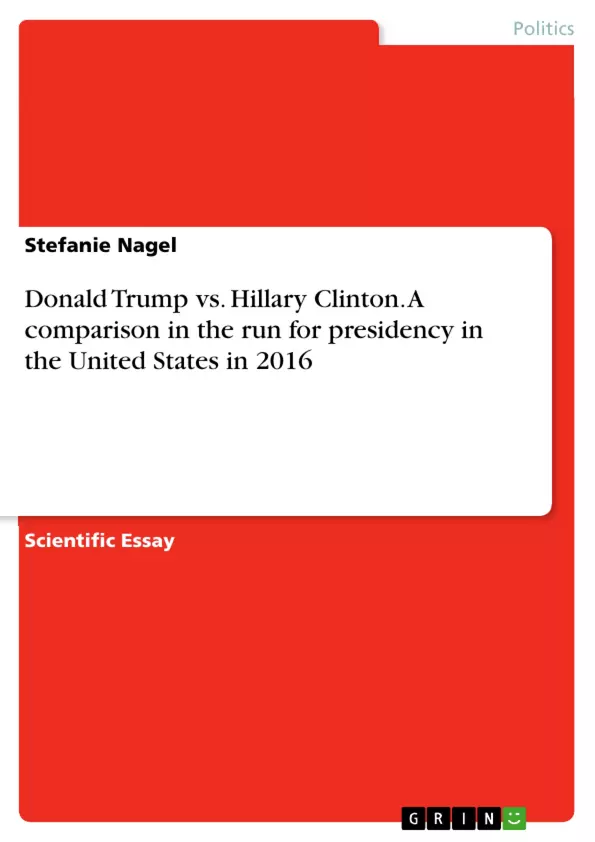In this paper analysis of the candidates of the 2016 presidential elections in the United States will be performed. Firstly, an outline the political system in the United States and how the presidential elections take place will be created. Then their respective biographies, opinions and goals on 2016’s key issues, campaigns and popularity will be taken into account, followed by a comparison of the two candidates based on the previous findings, and a conclusion.
On November 8th, 2016, the 45th President of the United States of America was elected. The Republicans nominated billionaire and business man Donald Trump while the Democrats were counting on Hillary Clinton as the first female presidential candidate in the history of the United States. Clinton and Trump have both been public figures for decades – Clinton as a livelong politician and Trump as an unconventional billionaire. The contrast between the two candidates could not have been bigger.
According to a Washington Post-ABC News poll from May 2016, the presidential race between Hillary Clinton and Donald Trump was a competition between two candidates viewed unfavorably by a majority of the electorate. The voters’ motivation was mostly to vote against the candidate they dislike rather than voting in favor of the person they wanted to lead them (Balz, Clement 2016).
As the leader of a country that has the ability to shape the world, the American president can be named the most powerful person on the planet. Therefore, the presidential elections do not only affect the United States itself but also a fair amount, if not every other country in the world.
Inhaltsverzeichnis (Table of Contents)
- INTRODUCTION
- The political system in the United States
- The role of the president in the United States
- Political parties and presidential elections in the United States
- HILLARY CLINTON: THE DEMOCRATIC CANDIDATE
- Biography
- Political goals during the campaign
- Economy
- Healthcare
- National security
- Immigration
- Environment
- Gun control
- Foreign policy
- Issues addressed only by Clinton
- The campaign
- Popularity
- In the Democratic Party
- In the United States
- Worldwide
- DONALD TRUMP: THE REPUBLICAN CANDIDATE
- Biography
- Political goals during the campaign
- Economy
- Healthcare
- National security
- Immigration
- Environment
- Gun control
- Foreign policy
- Issues addressed only by Trump
- The campaign
- Popularity
- In the Republican Party
- In the United States
- Worldwide
- COMPARISON
- Biography
- Political goals during the campaign
- Economy
- Healthcare
- National security
- Immigration
- The environment
- Gun control
- Foreign policy
- Issues addressed by only one of the candidates
- The campaign
- Popularity
- In their respective party
- In the United States
- Worldwide
Zielsetzung und Themenschwerpunkte (Objectives and Key Themes)
This paper analyzes the candidates of the 2016 presidential elections in the United States. The author provides an outline of the political system in the United States and how the presidential elections take place. The paper then examines the respective biographies, opinions and goals on key issues, campaigns and popularity of the candidates, followed by a comparison based on the previous findings.
- The American political system and the role of the president
- Key policy differences between Hillary Clinton and Donald Trump
- Campaign strategies and popularity of both candidates
- Comparison of the candidates based on their policy stances and campaign strategies
- The influence of the presidential election on the United States and the world
Zusammenfassung der Kapitel (Chapter Summaries)
The introduction provides a background on the political system in the United States, focusing on the role of the president and the process of presidential elections. It highlights the significance of the 2016 presidential election, as the first time a woman was running for the position, and emphasizes the contrast between the candidates, Hillary Clinton and Donald Trump. The introduction also discusses the importance of the president's position as a powerful figure in the United States and around the world.
The chapter on Hillary Clinton covers her biography, her political goals during the campaign, including her stances on key issues such as the economy, healthcare, national security, immigration, the environment, gun control, and foreign policy. It also examines her campaign strategy and her popularity within the Democratic Party, in the United States, and globally.
The chapter on Donald Trump follows a similar structure, discussing his biography, his political goals during the campaign, and his stances on key issues. It also examines his campaign strategy and his popularity within the Republican Party, in the United States, and globally.
The comparison chapter analyzes the differences and similarities between the two candidates based on their biographies, political goals, and campaign strategies. This includes a discussion of their key policy positions, their approaches to national security, and their foreign policy agendas. The chapter also examines the unique issues addressed by each candidate and explores the overall popularity of both candidates within their respective parties, in the United States, and globally.
Schlüsselwörter (Keywords)
This analysis focuses on the 2016 presidential elections in the United States, examining the candidates, Hillary Clinton and Donald Trump, their policy stances, and their campaigns. Key themes include the American political system, the role of the president, key policy differences between the candidates, campaign strategies, popularity, and the influence of the election on the United States and the world.
- Quote paper
- Stefanie Nagel (Author), 2017, Donald Trump vs. Hillary Clinton. A comparison in the run for presidency in the United States in 2016, Munich, GRIN Verlag, https://www.grin.com/document/415872



